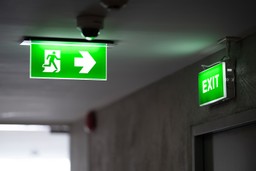How to Improve Workplace Fire Safety with Gerda Security
Workplace fire safety is about protecting lives and property while ensuring compliance with legal responsibilities. It involves identifying risks, preparing for emergencies, and maintaining safety systems. In this guide, we’ll explore every aspect of workplace fire safety, from conducting risk assessments to understanding the importance of fire safety doors. By following these practices, you can… Continue reading How to Improve Workplace Fire Safety with Gerda Security
Workplace fire safety is about protecting lives and property while ensuring compliance with legal responsibilities. It involves identifying risks, preparing for emergencies, and maintaining safety systems.
In this guide, we’ll explore every aspect of workplace fire safety, from conducting risk assessments to understanding the importance of fire safety doors. By following these practices, you can create a safer environment for everyone.
Why Workplace Fire Safety Is Crucial
Fires can cause devastating damage to workplaces, endangering employees and disrupting operations. Beyond physical harm, failing to implement fire safety measures can result in legal consequences under UK law, particularly the Regulatory Reform (Fire Safety) Order 2005. This legislation requires all businesses to assess fire risks, maintain safety equipment, and provide employee training.
A safe workplace doesn’t just happen – it’s the result of careful planning and ongoing vigilance. Whether it’s installing fire alarms, inspecting equipment, or conducting training, every step helps reduce fire-related risks.
Legal Responsibilities: What Employers Need to Know
Employers are legally obligated to create a fire-safe environment for employees, visitors, and contractors. Key responsibilities include:
- Fire Risk Assessments: Regularly assess the workplace for potential fire hazards and risks.
- Inform Employees: Ensure employees are aware of identified risks and know how to respond during emergencies.
- Equipment Maintenance: Keep all fire safety systems in working order.
- Training Programs: Provide regular training to teach employees about fire prevention and evacuation procedures.
Failure to comply with these duties can result in fines or legal action. For more details about fire door safety, check out our guide to fire door safety features.
How to Conduct Effective Fire Risk Assessments
Fire risk assessments are the cornerstone of workplace fire safety. These assessments help you identify hazards, evaluate risks, and take steps to prevent fires. Follow these steps for a thorough assessment:
Identify Hazards
Pinpoint potential fire hazards, such as:
- Ignition sources: heaters, electrical appliances, and machinery.
- Fuel sources: paper, wood, chemicals, and other flammable materials.
Evaluate Risks and People at Risk
Consider who might be affected in the event of a fire, including employees, visitors, and vulnerable individuals like the elderly or disabled.
Implement Preventative Measures
Mitigate risks by removing or reducing hazards. For instance, store flammable materials safely and ensure electrical equipment is maintained properly.
Review and Update Assessments
Fire risks evolve as workplaces change. Regularly review your assessments to address new hazards or changes to the environment.
Fire Safety Measures: Building a Safer Workplace
Once risks are identified, it’s time to act. Fire safety measures ensure your workplace is prepared for emergencies.
Fire Detection Systems
Install reliable smoke detectors and fire alarms in key areas. Regularly test and maintain these systems to ensure they function correctly.
Fire Safety Doors: A Critical Barrier
Fire safety doors play a vital role in slowing the spread of fire and smoke. They provide critical time for evacuation and protect escape routes.
Emergency Evacuation Plans
A clear evacuation plan is essential. Include:
- Well-marked exit routes.
- Assembly points away from danger zones.
- Assigned fire marshals to guide people during an evacuation.
Training and Awareness: Empowering Employees
Training is a critical part of improving fire safety in the workplace. Well-informed employees are better prepared to prevent fires and respond during emergencies.
What Training Should Include
- Using Firefighting Equipment: Teach employees how to operate extinguishers and other tools.
- Recognising Hazards: Educate staff on identifying potential fire risks.
- Evacuation Drills: Conduct regular drills to familiarise employees with escape routes and procedures.
Training should be an ongoing process, reinforced by periodic refreshers to ensure everyone stays prepared.
Maintaining Fire Safety Systems
Even the best safety measures need regular maintenance to remain effective.
- Inspect Safety Equipment: Regularly check fire alarms, sprinklers, and extinguishers.
- Test Fire Safety Doors: Ensure doors close properly and are free of damage.
- Review Policies: Update safety plans to reflect workplace changes and new regulations.
To explore this further, you can find more insights in our guide to fire door maintenance.
The Role of a Proactive Fire Safety Culture
Creating a culture that values safety is key to preventing fires. Encourage employees to:
- Report hazards promptly.
- Follow fire safety protocols.
- Participate actively in drills and training sessions.
Recognising and rewarding proactive safety behaviours can reinforce this culture.
By following these guidelines and maintaining a proactive approach, you can ensure your workplace prioritises fire safety while complying with legal requirements.For more information on fire safety solutions, visit our commercial sector page.
Frequently Asked Questions
Are fire risk assessments mandatory?
Yes, under UK law, regular fire risk assessments are required in all workplaces.
Why are fire safety doors important?
They contain fire and smoke, providing critical time for evacuation and protecting escape routes.
How often should fire safety equipment be inspected?
Equipment should be inspected at least annually, with more frequent checks for high-risk environments.
What should an evacuation plan include?
Clearly marked exits, designated assembly points, and assigned roles for fire marshals.



